All About Home Window Sizes
Home > All About Home Window Sizes
The beauty about building your own home, or adding an extension, is being able to choose your window size. Yes, not all home windows measure the same. There are, of course, averages, but following them is not essential.
If you’re worried about window coverings, like drapes and screens, then push that headache aside–window coverings are primarily customizable. With Screenmobile, it is the case, anyway.
If you’re looking for information on the different types of windows and home window sizes, you’ve come to the right place. We consider ourselves window experts, and we’re more than happy to share our knowledge with you.
What is a standard window size?

Standard window sizes vary but within set limitations. It’s easy to order window replacements from the likes of Lowes or HomeDepot. Window screens are readily available, with drapes and fabrics already cut to size, facilitating your interior design and shopping needs.
However, no two detached houses are built the same (to an extent). Your house may be similar to the Smiths down the road, but don’t you want your home to showcase some uniqueness? A great way to have your home stand apart from the neighbors is by choosing different window sizes.
How to choose a window size for your home?
Four factors to consider when deciding what window type and size to install in your home are:
- Space available: Windows that open in or out need more space. A small room could benefit from higher windows, and a large room could benefit from a picture window.
- Orientation of the room: North-facing rooms should have more oversized windows to let in more natural light.
- Energy efficiency goals: Triple-glazed windows are the best for home insulation and bill reduction, but do the windows you envisage come in triple glazing? You should also consider the solar screens you’ll install (although Screenmobile provides custom screens).
- Budget: Cost is often the deciding factor when it comes to home renovations, but consider it an investment rather than an expenditure without return.
Window size measurements
When measuring for your new windows, it’s good to know that you should always add half an inch to the height and width for ease of installation. Windows also follow a four-digit notation: width (ft/in) height (ft/in). So, a window that measures 45″ x 45″ will be noted as 4545.
Energy Efficiency of Windows
Between 25%–30% of residential heating and cooling costs are attributed to windows. If you want to cut the costs of your bills, then you should be looking at insulating your windows. Achieve this by installing double or triple-glazed window panes, choosing the correct window treatments and the best window frame, and ensuring that windows fit cozily without gaps bordering the frame.
Single, Double & Triple Pane Windows
This is about how many panes of glass are in your windows. It’s very rare to come across single-pane windows in modern homes. Windows are one of the first areas that are improved when wishing to insulate your home and have it rank higher on the energy efficiency barometer.
Another way to say this is single, double, or triple-glazed windows.
Different types of windows
So now you know what size window you want/need, have you thought about what type of window you desire? Of course, there is a choice, there is always a choice, and we have the pleasure of listing them out here for you:
Double-hung/Sash Windows
These are windows where both sashes open vertically and tilt for cleaning and ventilation purposes. Single-hung windows are more common in older buildings. The double-hung windows are a much safer option when you have kids, as you can slide down the upper sash to ventilate your home rather than leaving the bottom sash dangerously wide open.
Picture Windows
These windows are generally large and can be considered partial wall replacements. They are not functional like traditional windows–they offer the view but do not open. Picture windows are very common in office buildings, restaurants, and homes with amazing views.
Slider Windows
Think double-hung windows on their sides. Slider windows are easier to open and close without lifting or pulling. They come in various sizes so that you can have smaller ones for your basement or larger ones in bedrooms.
Bay Windows

These windows are the most aesthetic in the selection. They offer a nook in your room, adding character and style. It’s a window that juts out from your wall and is paned on three sides, the two sides moving out diagonally. They are ideal for extra seating, storage, and book reading.
To note, bay windows generally don’t open. The middle window is often a picture window, with some side windows operating as casement windows.
Casement Windows
These windows operate like doors. They are attached with hinges and open out. Not convenient if you lack exterior space or are prone to strong winds and storms. Modern casement windows operate with a crank, making them easier to work.
Awning Windows
These are windows that open out at a slant. They offer more privacy as the window isn’t fully opened while promoting natural light and ventilation. Awning windows are commonly found in bathrooms and on mobile homes.
Custom Window
Be unique and choose your own window style and shape. You don’t have to decide on an average window size, and most window companies offer customized services. You can have any opening fitted with a window, with functions of your choosing.
Different window covering types
Regardless of the type of window you choose, its size, orientation, and shape, award-winning Screenmobile have you covered. We provide custom screens with various colors and fabrics to choose from; no need to worry about finding window treatments that fit!
Find your local Screenmobile and get your unique windows the perfect screens.
We are America's Neighborhood Screen Stores®
Request a Free Estimate
Complete the form below, and we will contact you to arrange a free estimate for your home.
Screenmobile.com uses cookies to improve your experience on our website. These cookies help analyze our site traffic, understand where our visitors are coming from, and may share your information with partner companies. By browsing our website, you agree to our use of cookies. Learn More.
Don’t Miss Our Latest News and Ideas for Your Home
Use the button below to sign-up for our newsletter.



